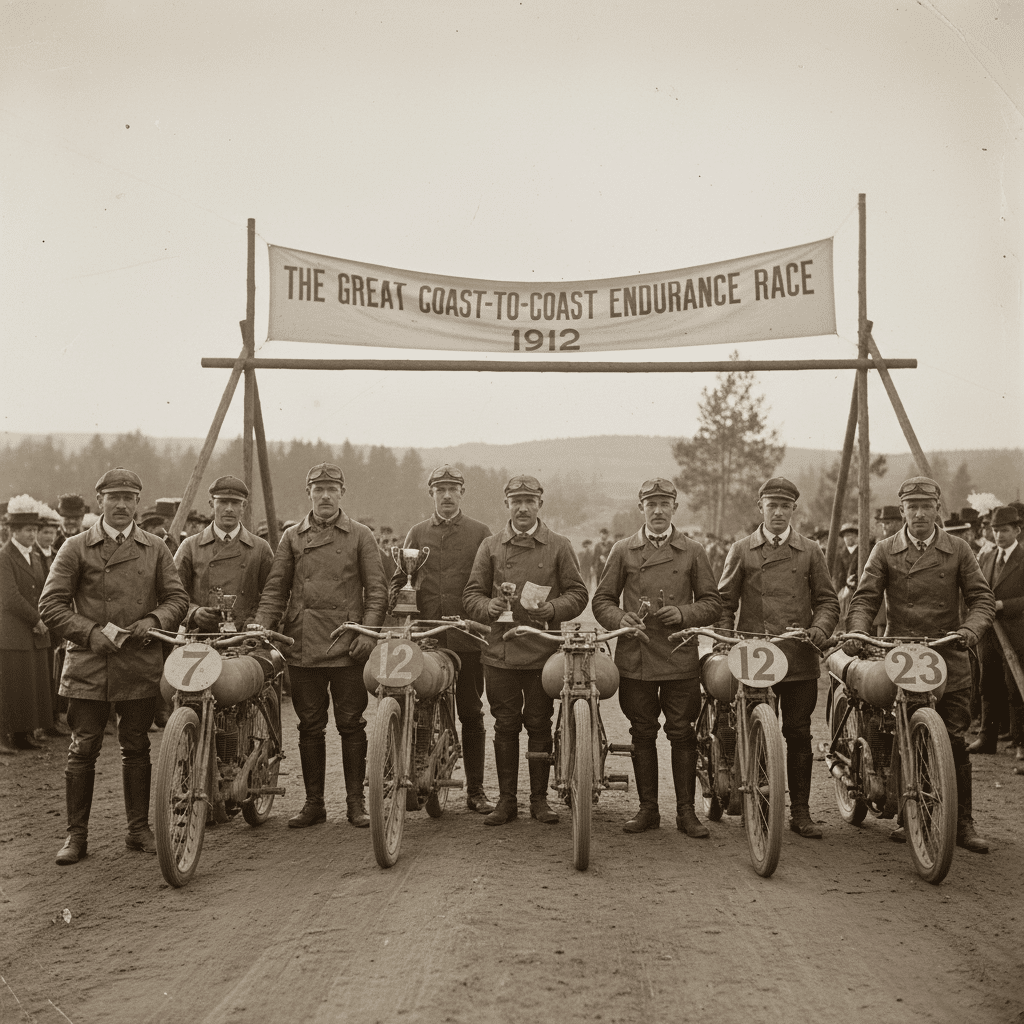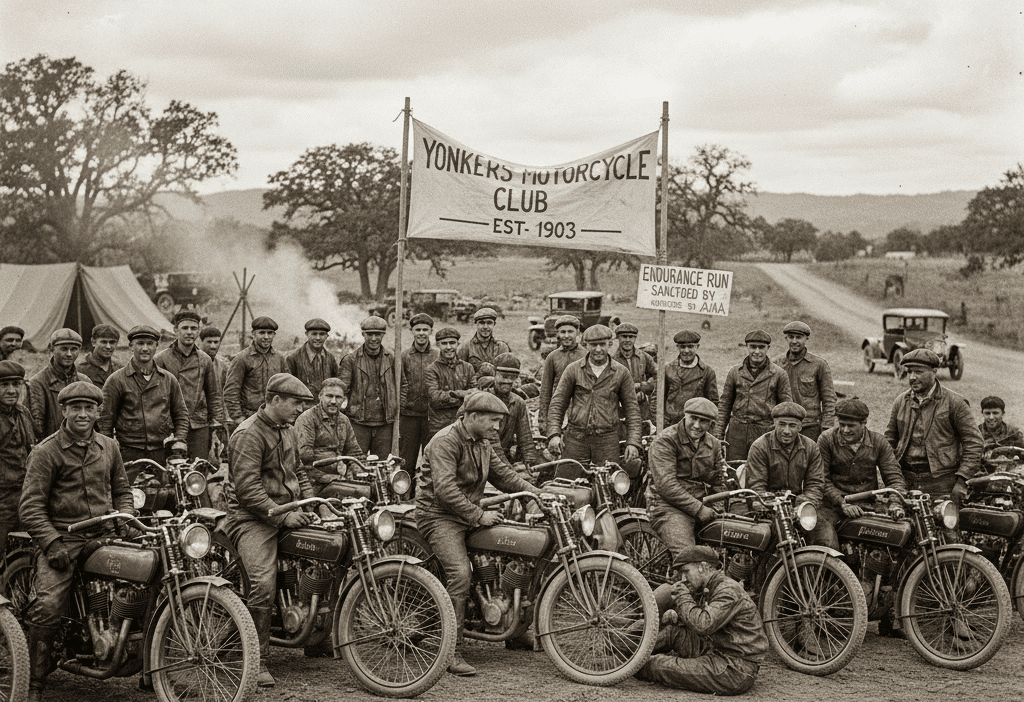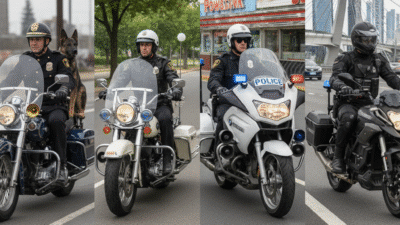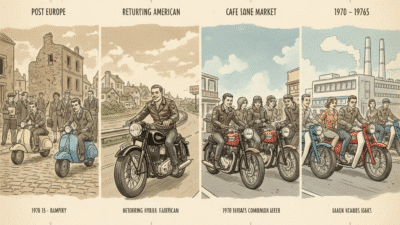Prepare to rev your engines and embark on a thrilling journey back in time, where the roar of primitive motors first echoed across dusty roads and a new culture was born! This isn’t just a history lesson; it’s an exhilarating exploration of early motorcycle clubs and their history, a deep dive into the foundational moments that shaped the very spirit of motorcycling as we know it today. Before the widespread highways, before the iconic leather jackets became a uniform, a band of spirited individuals forged connections, pushed boundaries, and unleashed the true potential of two-wheeled freedom. They didn’t just ride motorcycles; they built a community, a lifestyle, and a legacy that continues to inspire millions.
These pioneering clubs were more than mere social gatherings; they were crucibles of innovation, camaraderie, and an unyielding passion for the open road. From humble beginnings, they transformed a novel invention into a cultural phenomenon, laying the groundwork for everything from competitive racing to the global biker brotherhood. Get ready to discover the electrifying stories of the early trailblazers who literally kickstarted the world of motorcycling!
Pros and Cons
| Pros | Cons |
|---|---|
| – Strong sense of community and brotherhood | – Limited road infrastructure |
| – Advocated for rider rights and road improvements | – Early motorcycles were unreliable and hard to maintain |
| – Drove innovation in motorcycle design and engineering | – Public perception could be mixed or negative |
| – Organized thrilling races and endurance events | – High risk of accidents due to primitive technology |
| – Provided practical support and mechanical advice | – Membership could be exclusive |
1. The Dawn of Dissent: America’s Earliest Enthusiast Gatherings
Imagine a world where the automobile was still a curious novelty, and the idea of a motorized bicycle was nothing short of revolutionary. This was the landscape at the turn of the 20th century when the very first motorcycle enthusiasts began to emerge. These weren’t yet organized clubs with formal structures, but rather informal gatherings of intrepid individuals who had succumbed to the irresistible allure of the internal combustion engine strapped between two wheels. They were pioneers, often tinkering with their machines in sheds and garages, sharing tips, and, most importantly, sharing the thrill of the ride.
In cities like New York, Chicago, and San Francisco, small groups of riders would spontaneously converge, eager to compare their latest mechanical modifications or simply to share the exhilaration of a Sunday ride. These were the true “early adopters,” often well-to-do gentlemen who could afford the nascent technology and were fascinated by its potential. They represented a nascent counter-culture, distinct from the horse-and-buggy norm, and even from the emerging car culture. Their machines, often rudimentary and temperamental, demanded a certain mechanical aptitude and a daring spirit. This period, roughly from the late 1890s to the early 1900s, was characterized by pure, unadulterated passion. It was an era where the concept of the motorcycle itself was still taking shape, with inventors like Gottlieb Daimler having laid crucial groundwork for the gasoline engine. You can delve into the fascinating origins of two-wheeled transport by exploring how Gottlieb Daimler and the first gasoline motorcycle kickstarted this revolution. These early riders didn’t just buy a machine; they invested in a dream, and that dream was the genesis of everything that followed.

2. The Formation of Federations: FAM and Early National Bodies
As the number of individual riders grew, so did the desire for organization, shared standards, and a collective voice. The informal gatherings of the early 1900s soon gave way to more structured associations, paving the way for national federations. The most prominent of these in the United States was the Federation of American Motorcyclists (FAM), founded in 1903. This was a monumental step, transforming isolated groups of riders into a unified movement. FAM wasn’t just about social rides; it aimed to standardize racing rules, promote road improvements, and lobby for the rights of motorcyclists.
Before FAM, there was no cohesive body to represent riders. Individual clubs faced local challenges independently. With FAM, a national network began to form, offering a platform for shared experiences and collective action. They organized national endurance runs, setting benchmarks for motorcycle reliability and rider skill. These events were crucial, not only for competition but also for demonstrating the practicality and durability of motorcycles to a skeptical public. The FAM’s existence also highlighted a growing trend: the motorcycle was becoming more than a toy; it was evolving into a viable mode of transport and recreation. Understanding the foundational elements like the evolution of early motorcycle engines is key to appreciating the technological leaps that enabled these machines to become reliable enough for organized events. FAM’s efforts directly contributed to the burgeoning motorcycle industry, providing a customer base that demanded better machines and infrastructure. While the FAM eventually gave way to the much larger and more enduring American Motorcyclist Association (AMA) in 1924, its role in unifying and formalizing early American motorcycling culture is undeniable.
3. The Trailblazers: Gentlemen’s Racing & Touring Clubs
With national organizations providing a framework, local clubs flourished, often with specific focuses. One of the earliest and most influential types were the “gentlemen’s clubs” dedicated to racing and organized touring. These clubs attracted individuals who saw motorcycling not just as a hobby but as a sport and an adventure. The Yonkers Motorcycle Club, established in 1903, stands as one of the very first formally chartered motorcycle clubs in America. Its members, predominantly from affluent backgrounds, were drawn to the thrill of speed and the challenge of long-distance rides.
These clubs were instrumental in pioneering competitive motorcycling. They organized early hill climbs, track races on dirt ovals, and challenging cross-country tours that tested both machine and rider. The San Francisco Motorcycle Club, founded in 1904, similarly championed organized rides and promoted the sport on the West Coast. Their activities weren’t just for prestige; they pushed manufacturers to innovate, leading to stronger frames, more powerful engines, and improved reliability. Imagine the sheer grit and determination required to navigate unpaved roads and rudimentary trails on early motorcycles! These riders were true adventurers, mapping out routes, sharing repair knowledge, and fostering a deep bond forged through shared adversity and exhilaration. These clubs often hosted elaborate social events, integrating motorcycling into the broader social fabric of their communities. It was a golden age of mechanical exploration and personal triumph, setting the stage for decades of motorsport passion.

4. The British Invasion: Pioneering UK Motorcycling Societies
Across the Atlantic, Great Britain was simultaneously developing its own vibrant motorcycling culture. With a rich history of engineering and a dense network of roads, the UK quickly became a hotbed for two-wheeled innovation and club formation. One of the most influential was the Auto-Cycle Union (ACU), established in 1903, though its roots trace back to the self-propelled vehicle committee of the Royal Automobile Club. The ACU rapidly became the governing body for motorcycle sport in the UK, much like FAM in the US.
Alongside the ACU, specialized clubs like the British Motor Cycle Racing Club (BMCRC), founded in 1909, focused intensely on competition. These clubs organized the legendary Tourist Trophy (TT) races on the Isle of Man, which quickly became the ultimate test of man and machine, drawing international attention and cementing the UK’s reputation as a motorcycling powerhouse. British clubs also emphasized “reliability trials,” which were challenging off-road events designed to prove a motorcycle’s endurance and performance in harsh conditions. These trials directly influenced motorcycle design, pushing for better suspension, stronger frames, and more durable engines. The British motorcycle industry, with iconic brands like Triumph, Norton, and BSA, flourished in tandem with these clubs, forming a symbiotic relationship that propelled the sport forward. From the cobbled streets of London to the rugged Scottish Highlands, British motorcycle clubs fostered a unique blend of engineering prowess, competitive spirit, and an enduring love for touring the countryside.
5. The Endurance Riders: Clubs Built on Reliability Runs
Beyond the thrill of speed, many early motorcycle clubs were founded on the principle of proving the machine’s capabilities through grueling endurance runs. These weren’t just joyrides; they were scientific experiments on wheels, meticulously documented and often sponsored by manufacturers eager to showcase the reliability of their latest models. Clubs like the Pittsburgh Motorcycle Club, formed in 1908, were renowned for their participation in and organization of these demanding events.
Reliability runs, sometimes stretching hundreds or even thousands of miles over unpaved roads, through diverse terrains, and in unpredictable weather, were the ultimate test. Riders faced constant mechanical breakdowns, flat tires, and the sheer physical exhaustion of long hours in the saddle. Yet, they persevered, driven by a shared passion and a collective mission to demonstrate the motorcycle’s utility. These runs were vital for dispelling public skepticism about motorcycles, proving they weren’t just noisy toys but dependable machines capable of serious travel. The camaraderie forged on these epic journeys was legendary; riders often had to help each other with repairs, navigate challenging sections, and share resources. These experiences built an unbreakable bond, transforming strangers into lifelong friends. The data collected from these runs provided invaluable feedback to manufacturers, leading to rapid advancements in motorcycle technology. These clubs, through their sheer endurance, fundamentally shaped the narrative around motorcycling, establishing it as a serious mode of transport and adventure.

6. The Social Hubs: Community & Camaraderie Beyond the Ride
While racing and reliability were significant draws, many early motorcycle clubs flourished primarily as social hubs. These were places where individuals, often feeling a bit like outsiders due to their passion for this newfangled machine, could find like-minded souls. Clubs like the Chicago Motorcycle Club, founded in 1905, and numerous smaller, regional clubs across the United States and Europe, emphasized the social aspect of motorcycling. They organized regular Sunday rides, picnics, dances, and even formal dinners, integrating the motorcycle into a broader social calendar.
These clubs provided a sense of belonging, a community that transcended mere transportation. Members exchanged stories, shared mechanical expertise, and often formed deep, lasting friendships. Wives and families were frequently included in social events, fostering a more inclusive atmosphere. For many, the club became a second home, a place where they could truly express their individuality while enjoying collective experiences. This emphasis on camaraderie was crucial in establishing motorcycling as a lifestyle rather than just a solitary pursuit. They were instrumental in shaping the perception of motorcyclists as respectable, community-minded individuals, a far cry from later, more rebellious stereotypes. These social bonds were as vital as the machines themselves, proving that the motorcycle was a catalyst for human connection. The concept of clubs centered around a shared passion wasn’t unique to motorcycles; one could argue that car clubs through history have also championed the social side of automotive enthusiasm, demonstrating a universal human need for community around shared interests.

7. The Precursors to Legend: Early Clubs Shaping Future Icons
The cumulative impact of these early motorcycle clubs was profound, laying the essential groundwork for the iconic motorcycle culture we recognize today. They weren’t just building communities; they were building a legacy, shaping the sport, the industry, and the image of the motorcyclist for generations to come. The lessons learned from early races, endurance runs, and social gatherings directly informed the development of more sophisticated machines and more organized events.
These clubs were the incubators for future legends, both human and mechanical. The organizational structures they established eventually paved the way for larger, more professional bodies like the American Motorcyclist Association (AMA), which continues to govern and promote motorcycling in the U.S. Their advocacy for better roads and rider rights created a more favorable environment for all motorcyclists. Furthermore, the aesthetic and ethos developed within these early clubs – the sense of freedom, adventure, and camaraderie – influenced everything from motorcycle design to popular culture. Many legendary figures in motorcycling history began their journey within these pioneering groups. The passion cultivated in these early clubs ensured that motorcycling would not remain a fleeting fad but would evolve into a powerful, enduring force. The spirit of these early clubs – the blend of individualism and community, challenge and camaraderie – remains the very heart of motorcycling, echoing in every throttle twist and every mile ridden today.

The story of early motorcycle clubs is a thrilling narrative of passion, innovation, and community. From the first informal gatherings of curious riders to the establishment of national federations and specialized touring and racing clubs, these pioneering groups forged a path that transformed a fledgling invention into a global cultural phenomenon. They pushed the boundaries of technology, proved the resilience of both man and machine, and, perhaps most importantly, built lasting bonds of camaraderie that defined the very essence of motorcycling. Their legacy is etched not just in history books, but in every rumble of an engine, every open road explored, and every shared laugh among riders. So next time you swing a leg over your bike, take a moment to appreciate the daring spirit of those early trailblazers who unleashed the roar and set the world in motion.
What’s your next adventure on two wheels? Whether it’s a cross-country tour or a local club ride, remember to keep your machine in top condition. You can find some excellent advice on tasks like how to check and replace the brake pads on your motorcycle or even the right way to wash a motorcycle to ensure your ride is always ready for the open road! Embrace the spirit of those early clubs and continue their tradition of exploration and passion!
Frequently Asked Questions
What was the purpose of early motorcycle clubs?
Early motorcycle clubs served multiple purposes: they provided a social outlet for enthusiasts, organized competitive events like races and endurance runs, advocated for rider rights and better road infrastructure, and fostered a sense of community and camaraderie among members.
When and where were the first motorcycle clubs formed?
The very first informal gatherings of motorcyclists began in the late 1890s, with formal clubs emerging around the turn of the 20th century. The Federation of American Motorcyclists (FAM) was founded in the US in 1903, and the Yonkers Motorcycle Club (USA) also formed in 1903, making them among the earliest chartered clubs. Great Britain also saw the formation of the Auto-Cycle Union (ACU) in 1903.
How did early motorcycle clubs impact motorcycle technology?
These clubs significantly influenced motorcycle technology through their organized events, particularly reliability runs and races. The demanding conditions of these events provided crucial feedback to manufacturers, leading to advancements in engine design, frame strength, suspension, and overall durability and performance of motorcycles.
Were early motorcycle clubs only for men?
While many early motorcycle clubs were predominantly male, some clubs did include women in their social events, and a few pioneering women even participated in rides and races. However, the culture of motorcycling, like many activities of the era, was largely male-dominated in its early stages.
What kind of events did early motorcycle clubs organize?
Early clubs organized a diverse range of events including:
- Endurance Runs: Long-distance rides testing machine reliability and rider stamina.
- Hill Climbs: Competitions to see which rider could ascend a steep incline fastest or highest.
- Track Races: Events held on dirt or paved ovals.
- Organized Tours: Group rides for pleasure and exploration.
- Social Gatherings: Picnics, dances, and formal dinners to foster community.
How did early motorcycle clubs contribute to road infrastructure?
Many early motorcycle clubs actively campaigned for improved road conditions. As riders frequently traversed unpaved and poorly maintained roads, they understood the dire need for better infrastructure and often lobbied local and national governments for road construction and maintenance.
What is the legacy of these early motorcycle clubs?
The legacy of early motorcycle clubs is immense. They laid the groundwork for modern motorcycling culture, established the framework for competitive racing, drove industrial innovation, and fostered a deep sense of community and camaraderie that continues to define the motorcycling world today. Their spirit of adventure and freedom remains central to the identity of riders globally.



